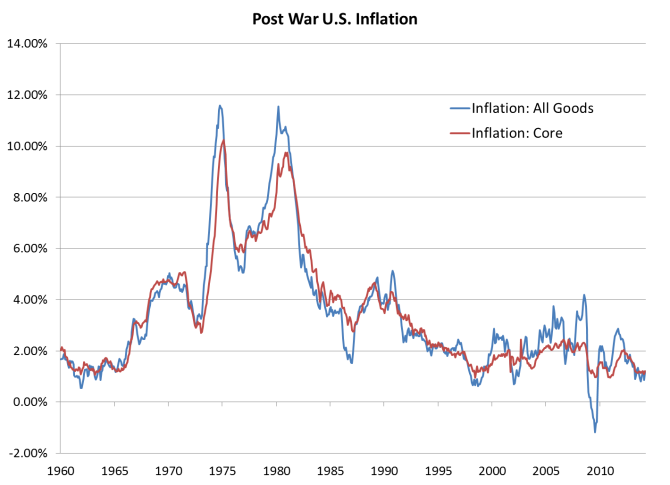Noah Smith has a short post questioning the reasoning of an earlier post of mine about stimulus spending. He includes a short numerical example which I reproduce below. Here’s Noah:
Suppose [the] fiscal “multiplier” is substantial. Specifically, suppose … $100 of tax rebates will increase GDP by $110. In this case, stimulus spending is a “free lunch.”
Now suppose that instead of doing tax rebates, the government can build a bridge. The social benefit of the bridge is $90, and the bridge would cost $100. In the absence of stimulus effects, therefore, the bridge would not pass a cost-benefit analysis. For simplicity’s sake, suppose that spending money on the bridge would create exactly the same stimulus effect as doing a tax rebate – spend $100 on the bridge, and GDP goes up by $110 from the stimulus effect.
In this case, the net social benefit of spending $100 building the bridge is $90 + $110 – $100 = $100.
And the net social benefit of spending $100 on a tax rebate is $110 – $100 = $10.Bridge wins!
Noah has a couple of subtle mistakes in his calculation. First, the increase in GDP from the stimulus isn’t completely a social benefit. Typically, every good produced is produced at some cost. If I go out to eat for lunch and buy $10 of Szechuan chicken, GDP goes up by $10. However, the net social benefit doesn’t go up by this amount. The gains to me (G) must be at least worth $10 otherwise I wouldn’t have willingly spent the money. The cost to the restaurant (C) can’t be more than $10 otherwise they wouldn’t have willingly provided that dish. The social benefit (SB) is the difference between the gains and the cost.
SB = G – C
If markets are fairly competitive then at the margin both G and C will be “close” to $10 and so the social benefit will in all likelihood be less than $10. What this means for Noah’s calculation is that the $110 stimulus might not really be worth $110. That’s ok however since this error is symmetric. It is worth pointing out however, that stimulus which is guided by the private sector typically passed cost/benefit tests of the kind I emphasize. In my example, G > 10 and C < 10 so SB = G – C must be positive.
The second error is more important. In his calculation, Noah is counting the out-of-pocket revenue outlay for the tax cut as a cost. This isn’t correct. The tax cut is a transfer. There are no direct social costs associated with the tax cut.
Let me try to rephrase Noah’s example to make it clear. He is considering two options:
OPTION 1: tax cut (or transfer) of $100
OPTION 2: government spending of $100
(i) In both cases the Treasury is deprived of $100.
(ii) In both cases the private sector gains $100 in after-tax income.
(iii) In both cases the private sector uses the additional income to spend or save (this is the source of the multiplier).
(iv) In OPTION 1 a bridge is built. The social costs (C) of the bridge include the value of time, energy, materials, effort, etc. The social benefit (B) of the bridge is the value of having the bridge.
In comparing these two options, we can ignore (i) – (iii) since they are the same in both policies. The only difference is (iv). Whether government spending is preferable depends only on whether B is bigger than C. Note that the magnitude of the multiplier doesn’t enter the comparison. It is symmetric in both cases. My argument is not “diametrically opposed to Econ 102 textbook Keynesianism” — GDP will go up by more under OPTION 2. The subtlety is that in Econ 102 we typically act as if maximizing GDP is the correct objective of public policy. This isn’t true though. GDP maximization can rationalize building pyramids, the Maginot Line, the bridge to nowhere, ethanol subsidies, … A social welfare criteria would skip these projects.
In the comments section to Noah’s post a number of readers make some points which are worth mentioning. One comment points out that many people don’t pay taxes and so wouldn’t benefit from a tax cut. Certainly, unemployed people won’t benefit from a tax cut. However, we could construct transfers that would reach these people. Rachel Maddow’s suggestion of sending people envelopes with money in them would work just fine. Also, many people and firms do pay taxes. Payroll tax cuts like those passed by the Obama administration are a particularly effective way of introducing stimulus. These simultaneously put money in people’s pockets not to mention the beneficial incentive effects of the policy.
Another commenter points out that calculating the social costs and benefits of a given project are quite difficult. This is absolutely true but it is a calculation that should be carefully considered none the less. In Noah’s example, the cost of bridge is probably closely approximated by $100. The benefit of the bridge is more difficult to assess. Such difficulties probably come up often. What is the benefit of protecting or cleaning up a wetland? What is the benefit of political stabilization in the Middle East? Tricky questions but questions that should be considered nonetheless.





